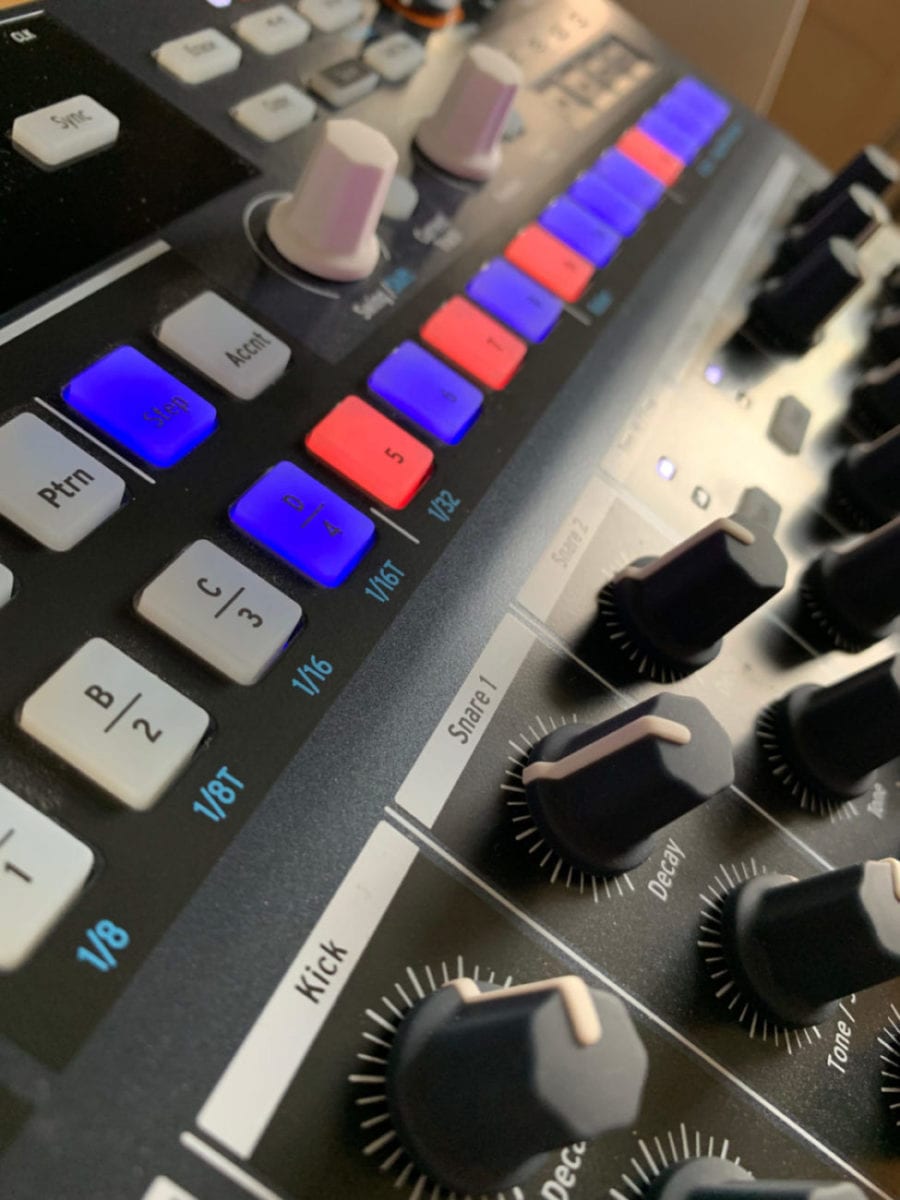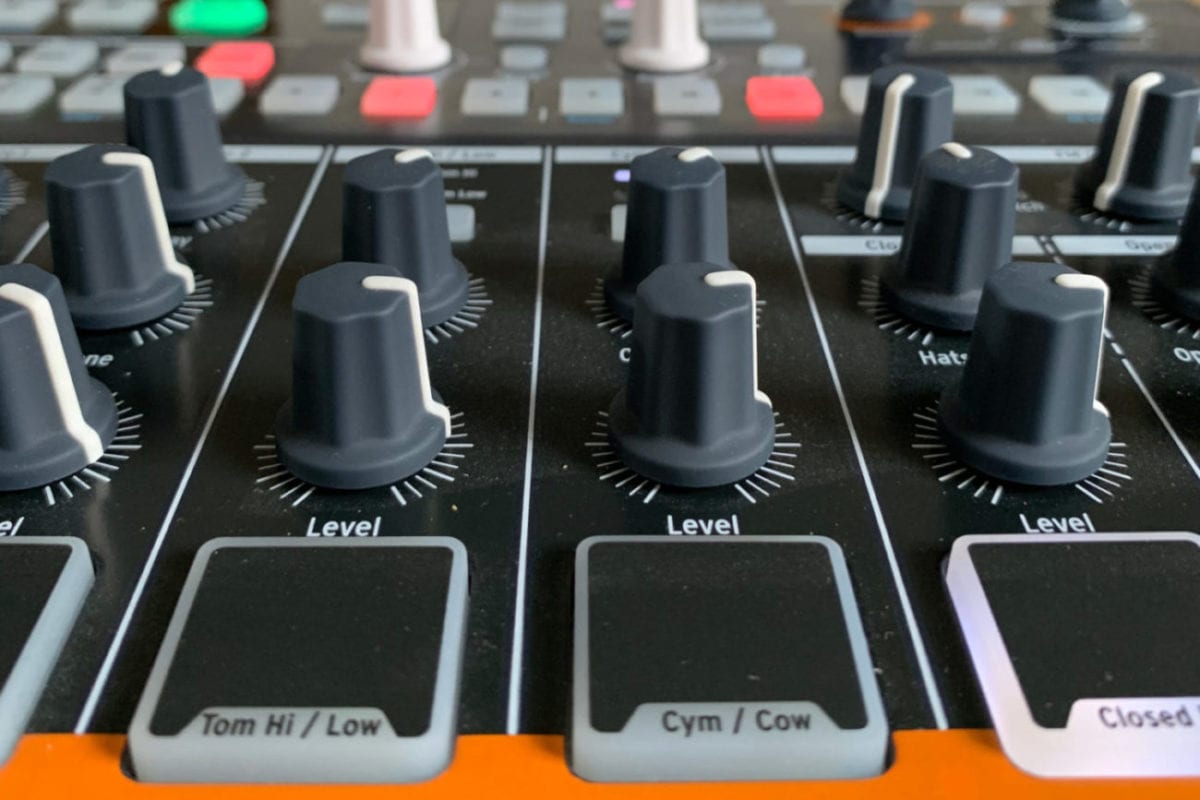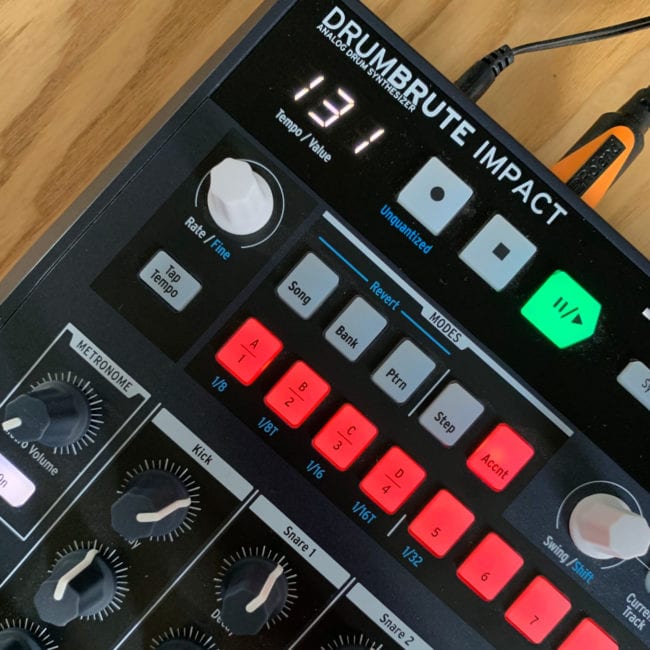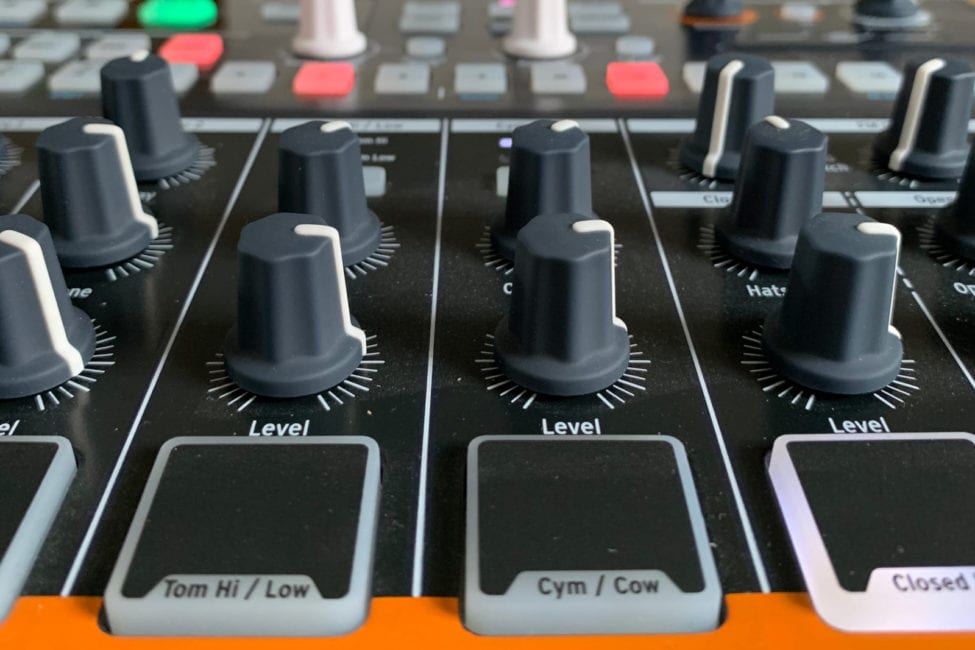Arturia’s original Drumbrute was a keenly placed product. The affordable end of the drum machine range has generally been one of compromise. Korg’s Volca Beats is constricted by a short four bar sequencer plus a reliance on modding to enhance MIDI connectivity and draw out the best from a weedy snare.
Roland’s solid Boutique offerings did disappoint analogue purists who also bemoaned the lack of individual outs, while the larger TR-8 felt like a decaffeinated take on the 808 and 909. Further down the scale, the toy like sonic templates of Akai’s Rhythm Wolf and Teenage Engineering’s Pocket Operator proves to be a non-starter for many. So did Arturia hit the sweet spot with their first step onto the market? Nearly.
While the unit was solidly constructed, the odd instrument perhaps needed a little too much post-processing in order to roughen them up. Although, with this in mind, each sound was mapped to an individual out, allowing those armed with FX units or pedals to go to town on the audio—a technique which was often applied to the 909, a machine with a reputation that needs a certain amount of taming to get the best out of it.
Still, it was a compromise when considering a machine for your needs—something ready to go out of the box versus something that might be integrating into a more mature setup. However Arturia have not stood still and evolved their entire Brute range into a fully fledged suite. Two new flavours of the Microbrute range hit the market, and this was then quickly joined by a new Drumbrute—the Drumbrute Impact.

"A drum machine that stands alone in its bracket—analogue, fully featured and utterly complete"
This is a machine that is focused on reigning it back in a little and introducing a degree of focus. It features a much smaller footprint, useful if you are conscious of table top space for small home studios or for gigging purposes. The sound design has seen an overhaul, with the amount of instruments reduced.
It is worth noting here this isn’t a simple culling, the capability of the sounds themselves has been given a significant overhaul and re-focused into a new collection. The most important reduction is that of the price, coming in at a really aggressive ~£259, nearly £100 cheaper than the larger original.
Out of the box, the Drumbrute is solid. No flex, bend or creaks to the body, with nice solid dials across the board and velocity responsive pads for the sounds. The top half of the panel is reserved for the sequencer—more on that later—with the lower half featuring the all important array of instruments. It is roughly the span of a fourteen inch laptop, compact but not fiddly.
Across the back, you have your various connectors. Sync options through MIDI, voltage clock and USB. Outs in the form of master out, headphone socket, and instrument outs—which are now combined into a logical foursome of kick, snare, hi-hats and FM Drum.
In terms of sound, we now have a single kick—down from the hard/soft types on the original model—a standard snare and a clap snare, low and high toms, cymbal and cowbell, closed and open hats, and the rather intriguing FM Drum. Your eyes are drawn to a new key feature here by the orange strip that runs across the bottom—”color”. Each sound has a “color” variant which impacts in different ways.
The kick becomes more distorted, the clap snare introduces a hefty dose of spread, the toms have a greater decay, hi-hats morph into an aggressive alter efo. “Color” effectively doubles the range of sounds that you’re able to achieve from the instruments. Added to this, at a global level, a distortion dial offers everything from warm saturation to a mangled red-lined growl. In essence, there is a lot to play with.

The sounds themselves are mostly fantastic. The kick can flip from deep subby house throbs up to a hard edged techno punch. The snare can devolve into a lovely white noise hiss. The hi-hats are metallic and crispy. The Drumbrute Impact is certainly more on the 808 spectrum of audio, although it is worth remembering that the 909 featured a lot of real life samples for some of its signature sound. Only the toms disappoint, not really having a rubbery twang, more of a spongy accent for syncopating the kick.
Let’s just take a moment here to put a particular spotlight on the wild card that is the FM Drum. Rather than a straight up piece of percussion, it is a multifaceted entity that you can play with in a melodic sense. It can vary from space invader plips, through heavily resonant ring modulated tones, right up to ‘Erotic Discourse’ levels of intensity. Feed what you’re doing through the instrument line out to a delay pedal and you can have a load of fun.
It is this sense of fun is where the Drumbrute Impact really comes alive. The sequencer that runs along the top of the unit is fantastic, something that you should not really be surprised by considering the increasingly industry standard Beatstep Pro and Keystep sequencers come from Arturia. Laying out a groove from 16 to 64 beats is simple and visual.
You will find yourself arranging elements on the step sequencer, blues and reds denoting accent, with the barest glance at a manual. You can get incredibly macro in terms of control—you can have individual steps flicking between standard and “color” inputs, swing and randomising can be applied in a global or per instrument scenario. Real time flair can be applied with the basic mute and solo functions, and there is a particularly neat array of indents in the upper right corner that allow repeats and rolls at various speeds.
It is also worth mentioning here that you can sequence to a rigid grid, play in a quantised sequence, or abandon the grid and have the playback replay unquantised inputs, flaws and all. For even more idiosyncrasy, you can introduce polyrhythms—a vital tool for techno productions—where you can have different elements running at different time signatures.

The Drumbrute Impact wants you to play. Sure, you can link up to your DAW and get completely obsessive with the software editor, but working out a live jam is so utterly rewarding and compelling. Put down a simple electro break, take the randomisation on the kick up to 20, bring in the FM Drum at its most rasping, link up some extra synths over MIDI to add to the mix, and then start improvising. You will lose hours in a raw electro improv hole.
If you’re looking for your first machine as a foray into the hardware scene—because it can clearly go a lot of miles on a bare percussion workout—or if you’ve just ventured out with a few small melodic units and you’re looking to tie them together with the all important metronome, there is not a lot in terms of competition for the price.
Add to this that you’re going to be crafting from a palette that is different from what feels like 90% of current releases in the music scene, and it is certainly a curve-ball proposition. With the only machines in this stretch of water being Behringer re-treading the 808 and 909 template, there is nothing else that is daring to do anything different. If you’re in the market right now, get some headphones on, check a demo. You might be surprised.
TECHNICAL SPECIFICATIONS
Box Contents
- DrumBrute Impact unit
- Power supply
Size & Weight
- Instrument size : 13.5 x 9.6 x 2.2 inches (342 x 243 x 57mm)
- Instrument weight : 4 lbs. (1.84 Kg)
Main Features
- 10 pure analog sounds: Kick, Snare 1, Snare 2, Tom Hi, Tom Low, Cowbell, Cymbal, Closed Hat, Open Hat, and FM Sound
- 64 patterns with up to 64 steps each
- Separate accent per drum
- Optional Color sound-shaping on all instruments (except Cowbell)
- Song mode for chaining patterns
- Polyrhythm capabilities: each drum track can be a separate length
- Swing: global or per instrument
- Randomness: generate pattern variations
- Pattern Looper for beat repeat functions
- Roller for real time instruments rolls
- Output Distortion with bypass
- Smart metronome with headphone override
- Multiple sync options: Internal / MIDI / Clock, including 1PPS, 2PPQ, DIN24, and DIN48
- USB MIDI interface
- Master output, & optional individual audio outputs for Kick, Snares, Hats and FM Sound
- 3.5mm headphone output



